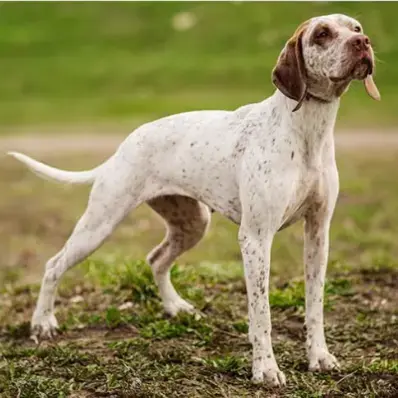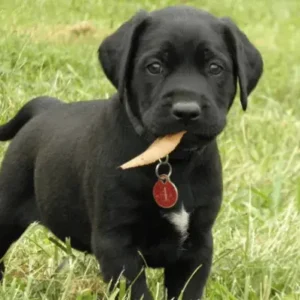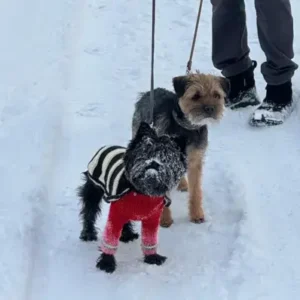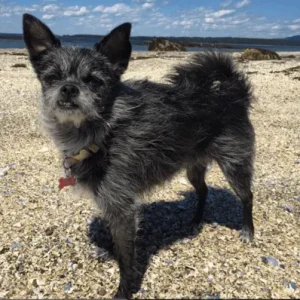Braque du Bourbonnais History/Origin
The Braque du Bourbonnais is one of the oldest pointing breeds, developed in France. The name “braque” comes from the French verb meaning “to aim or point,” and it refers to the breed’s role as a pointer. This purebred was mentioned in French literature as early as the late 1500s, already renowned for its strong hunting instincts.
French pointers, including the Braque du Bourbonnais, are believed to have originated from the same foundational breed, the Braque Francais, with each type named after the region where it was developed, such as the Braque Saint Germain from Saint Germain and the Braque d’Auvergne from the Auvergne region.
Braque du Bourbonnais History- source: Wikipedia
In the early 20th century, French breeders began working to improve the Braque du Bourbonnais’ conformation and field abilities. After World War I, the first Club du Braque du Bourbonnais was founded in 1925, aiming to restore the breed.
A breed standard was published in 1930, but the breed faced setbacks during World War II and strict standards focusing on appearance rather than performance. From 1963 to 1973, no pups were registered, signaling the breed’s near extinction.
However, in 1982, Michel Comte formed a second Club du Braque du Bourbonnais, which relaxed some breed standards and focused on restoring the breed’s hunting abilities.
By 1991, the breed had regained recognition from the Société Centrale Canine (SCC) and the Fédération Cynologique Internationale (FCI). The updated breed standard was officially published by the FCI in 1998.
Braque du Bourbonnais Personality
The Braque du Bourbonnais is one of the dog breeds that is lively and affectionate companion, known for its strong bond with humans due to its origins as a hunting partner. Highly intelligent and eager to please, they respond well to training, making them both cooperative and easy to handle.
With their friendly and sociable nature, they thrive in family environments, getting along well with people and other pets alike. Despite their active lifestyle, they maintain a gentle and quiet demeanor, enjoying both outdoor adventures and calm moments with their loved ones.
- Potential Challenges
The Braque du Bourbonnais’ strong hunting instincts mean they should be kept on a leash, as their prey drive can take over. Early training helps prevent unwanted barking, and consistency is key to housebreaking them. However, they can develop separation anxiety if left alone for too long, making them better suited for homes where someone is often present.
Braque du Bourbonnais Physical Appearance
The Braque du Bourbonnais is a medium-sized hunting dog with short hair. While he isn’t overly muscular, he has enough muscle to appear strong. He has a sturdy and stocky build, and his skin is smooth without being thin or wrinkled.
- Size
The Braque du Bourbonnais typically stands between 19 and 22.5 inches tall at the shoulder. They usually weigh between 35 and 53 pounds, giving them a well-proportioned and sturdy appearance.
- Coat color
Braque du Bourbonnais dogs come in several main colors, including brown, white, fawn, and spotted patterns. Their coats can be either solid or a mix of these colors with spots. Typically, they have short, dense fur that has a fine texture across their body, while the hair on their back is a bit longer and coarser.
Braque du Bourbonnais Gender Differences
There are slight size differences between male and female Braque du Bourbonnais dogs. Males tend to be stronger and heavier, giving them a more robust build compared to females. Despite these differences, both genders are equally affectionate and friendly, making them wonderful companions.
Braque du Bourbonnais Feed/Nutrition
The ideal Braque du Bourbonnais should be fed about 2.5 cups of food per day. Their diet should be tailored for a medium-sized breed with high energy. It’s important to maintain a regular feeding schedule and avoid leaving food out throughout the day.
Additionally, limit the number of treats they receive. Like all dogs, the Braque du Bourbonnais’s dietary needs will evolve from puppyhood to adulthood and into their senior years.
For specific dietary recommendations, consult your veterinarian, as individual dogs may vary significantly in weight, energy, and health. Mango can be given in moderation as a tasty treat, but be sure to remove the pit and skin before offering it to your dog.
Braque du Bourbonnais Health
The Braque du Bourbonnais breed is susceptible to some health conditions common among pointing breeds. Although they are generally healthy, certain individuals may face specific health issues.
- Hip Dysplasia: Hip dysplasia is a genetic condition where the hip joint doesn’t fit properly into the socket, leading to arthritis and pain as the dog ages. This can cause difficulty in movement and reduced activity levels. To prevent it, maintain a healthy weight, ensure regular exercise, and consider hip health screenings by a veterinarian, especially if there’s a family history.
- Entropion Eyes: Entropion is a condition where the eyelids roll inward, causing eyelashes to rub against the cornea, which can lead to irritation and potential vision loss. To prevent entropion, choose a reputable breeder who screens for eye conditions and schedule regular veterinary check-ups to identify issues early.
- Ectropion Eyes: Ectropion occurs when the eyelids droop outward, exposing the inner eyelid and making it prone to irritation and infection. This can cause excessive tearing and discomfort. Regular eye exams by a veterinarian and selecting dogs from healthy lines can help prevent this condition.
- Pulmonic Stenosis: Pulmonic stenosis is a heart condition characterized by narrowing of the outflow tract from the right ventricle to the pulmonary artery, which can lead to heart murmurs and heart failure. To help prevent it, choose a reputable breeder who conducts heart health screenings and schedules regular veterinary check-ups.
Braque du Bourbonnais Care and Grooming
To keep your Braque du Bourbonnais healthy and happy, establish a consistent care routine. Aim for at least one long walk of 30 minutes to an hour daily, along with shorter walks and active play sessions like fetch or agility training.
Regular exercise is essential for their physical and mental well-being, helping to prevent boredom and unwanted behaviors.
Check their ears for dirt and pests regularly and clean them as advised by your vet. Trim their nails monthly to avoid clicking on the floor; a groomer can help with this. Daily teeth brushing is important for oral health, and your veterinarian can show you the proper technique.
While they are not hypoallergenic, their short coats make grooming easy, requiring only weekly brushing. Because of their shorter coats, Braque du Bourbonnais isn’t suited for extreme temperatures, so be sure to prepare if you live in very hot or very cold climates. Additionally, training your dog not to bark can help manage noise levels, especially in more sensitive environments or during outdoor activities.
Interesting Facts
- Many Braque du Bourbonnais dogs are naturally tailless or have very short tails, a unique characteristic that sets them apart from other breeds.
- While primarily known as pointers, they are also skilled retrievers and trackers, showcasing their versatility in various hunting roles.
Best For
The Braque du Bourbonnais makes an excellent pet for active individuals or families who enjoy spending time outdoors. They thrive in environments where they can engage in regular exercise and play, making them ideal companions for those who love hiking, running, or participating in dog sports. Their friendly and affectionate nature also suits families, as they bond well with children and other pets.
Top Names
| Male Braque du Bourbonnais Names | Female Braque du Bourbonnais Names |
| Hunter | Bella |
| Milo | Luna |
| Oscar | Daisy |
| Cooper | Ruby |
| Finn | Nala |








 Braque du Bourbonnais History- source:
Braque du Bourbonnais History- source: 

 White and brown Braque du Bourbonnais- Source:
White and brown Braque du Bourbonnais- Source:  White Braque du Bourbonnais- Source:
White Braque du Bourbonnais- Source:  Fawn Braque du Bourbonnais- Source:
Fawn Braque du Bourbonnais- Source: 






